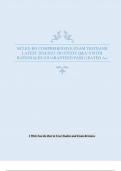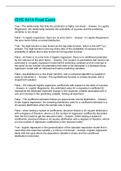NCLEX-RN COMPREHENSIVE EXAM TESTBANK
LATEST 2024/2025 180 STUDY Q&A’S WITH
RATIONALES (GUARANTEED PASS) | RATED A+
I Wish You the Best in Your Studies and Exam Revision.
,NCLEX-RN COMPREHENSIVE EXAM TESTBANK LATEST 2024/2025 180 STUDY
Q&A’S WITH RATIONALES
1. During a community health assessment at a local school’s parent-teacher conference, the nurse
encounters several parents and caregivers. Based on their shared histories and lifestyles, the
nurse determines the risk factors for hypertension among them. Which of the following
individuals is at the HIGHEST risk for developing hypertension?
Best online courses
A. A 45-year-old African-American attorney with a family history of
hypertension, who has a sedentary lifestyle, consumes a diet high in sodium, and
recently had a significant weight gain.
B. A 60-year-old Asian-American shop owner with a BMI of 28, who has well-
managed type 2 diabetes, takes medications for high cholesterol, and engages in regular
physical activity.
C. A 40-year-old Caucasian nurse who is a vegetarian, has a healthy BMI, is a non-
smoker but reports high levels of work-related stress and consumes excessive amounts of
caffeine.
D. A 55-year-old Hispanic teacher who smokes occasionally, has a healthy BMI,
participates in a moderate-intensity exercise program, and recently started taking oral
contraceptives.
E. A 50-year-old Middle Eastern engineer with a BMI of 26, who has a family
history of cardiovascular diseases, does not engage in any form of exercise, and has
recently been diagnosed with obstructive sleep apnea.
F. A 52-year-old Native American artist with a family history of kidney disease,
who smokes a pack of cigarettes daily, drinks alcohol excessively, and reports
infrequent physical activity.
G. A 43-year-old European baker who has a BMI of 30, often deals with job-related
stress, consumes a diet rich in pastries and sweets, and has a sedentary lifestyle due to
long work hours.
Correct Answer: A. A 45-year-old African-American attorney with a family history of
hypertension, who has a sedentary lifestyle and consumes a diet high in sodium.
African-American adults have a higher prevalence of hypertension compared to other racial and
ethnic groups in the United States. This individual also has a family history of hypertension, a
sedentary lifestyle, and a diet high in sodium, which are all risk factors for hypertension.
,Therefore, this individual is at the greatest risk for developing hypertension among the given
choices.
Option B. 60-year-old Asian-American shop owner: Although age is a risk factor for
hypertension, this individual has well-managed type 2 diabetes and engages in regular
physical activity. Their BMI of 28 suggests being overweight, but the combination of
other factors makes this individual’s risk lower than the African-American attorney.
Option C. 40-year-old Caucasian nurse: While this individual reports high levels of
work-related stress, which can be a risk factor for hypertension, they have a healthy BMI,
are a vegetarian, and a non-smoker. These factors help offset their risk, making them less
likely to develop hypertension compared to the African-American attorney.
Option D. 55-year-old Hispanic teacher: Although this individual smokes occasionally,
which is a risk factor for hypertension, they have a healthy BMI and participate in a
moderate-intensity exercise program. These factors help reduce their risk, making them
less likely to develop hypertension compared to the African-American attorney.
2. A 15-year-old female with a history of depression is brought to the emergency department.
Nurse’s Notes:
1115: A 15-year-old female with a history of depression and recent relationship troubles with her
close friends is brought to the emergency department by her concerned parents after they found
an empty bottle of maximum-strength acetaminophen in her room. Upon questioning, the patient
tearfully admits to ingesting 15 tablets of the medication 45 minutes ago. She is visibly anxious
and frequently looks at the marks on her wrists, which seem to be superficial scratches.
Vital signs as of 1115:
Blood pressure: 120/70
Heart rate: 88 bpm
Respiratory rate: 18 bpm
Oxygen saturation: 98% on room air
As the nurse prepares to address the situation, several orders from the primary care provider
come in. Which of the following orders should the nurse prioritize and carry out first?
A. Perform gastric lavage
B. Administer acetylcysteine (Mucomyst) orally
C. Start an IV with Dextrose 5% and 0.33% normal saline
D. Have the patient drink activated charcoal mixed with water
, E. Conduct a psychiatric evaluation.
F. Apply wrist restraints to prevent further self-harm.
Correct Answer: B. Administer acetylcysteine (Mucomyst) orally
Although gastric lavage can help remove any remaining acetaminophen from the stomach, it is
not the priority intervention in this situation. Administering the antidote, acetylcysteine
(Mucomyst), should be the primary focus to counteract the toxic effects of acetaminophen on the
liver. Acetylcysteine is the antidote for acetaminophen toxicity and should be administered as
soon as possible to maximize its effectiveness in preventing liver damage.
3. A 68-year-old male with a history of hypertension and diabetes has undergone a cardiac
catheterization to evaluate potential coronary artery disease. He has a known allergy to iodine-
based contrast agents, which required premedication with corticosteroids and antihistamines. The
procedure was successful, but the patient experienced brief hypotension during the
administration of the contrast material. The patient has been transferred to the cardiac step-down
unit for observation, and the nurse is aware of the potential complications that can arise in the
initial 24 hours post-procedure. Which complication should the nurse monitor closely during this
period?
A. Persistent angina despite being at rest and receiving nitroglycerin
B. Thrombus formation leading to decreased peripheral pulses and cyanosis
C. Dizziness accompanied by a sudden drop in blood pressure when standing
D. Gradual decrease in blood pressure with no other symptoms
Correct Answer: B. Thrombus formation
In the initial 24 hours after a cardiac catheterization, the nurse should closely monitor for
thrombus formation. Thrombus formation at the catheterization site can lead to serious
complications, such as decreased blood flow to the extremities or embolization to other parts of
the body. While the other options (angina at rest, dizziness, and falling blood pressure) can be
potential concerns, thrombus formation is the most critical complication to monitor for during
the immediate post-procedure period.
4. A 43-year-old male with a history of recurrent renal calculi is admitted to the emergency
department presenting with severe left flank pain radiating to the groin, nausea, and an episode
of vomiting. He also reports burning and urgency during urination. His vital signs reveal a
temperature of 100.8ºF (38.2ºC), blood pressure of 145/90 mmHg, pulse of 100 beats/min, and
respiratory rate of 20 breaths/min. The client is visibly anxious and uncomfortable due to the
severity of the pain. The nurse is assigned to care for the patient and must prioritize the nursing
goals to ensure optimal care. Which nursing goal should be the top priority for this client?





